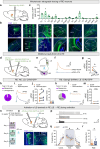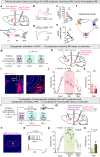An ultra-short-acting benzodiazepine in thalamic nucleus reuniens undermines fear extinction via intermediation of hippocamposeptal circuits
- PMID: 38877285
- PMCID: PMC11178775
- DOI: 10.1038/s42003-024-06417-w
An ultra-short-acting benzodiazepine in thalamic nucleus reuniens undermines fear extinction via intermediation of hippocamposeptal circuits
Abstract
Benzodiazepines, commonly used for anxiolytics, hinder conditioned fear extinction, and the underlying circuit mechanisms are unclear. Utilizing remimazolam, an ultra-short-acting benzodiazepine, here we reveal its impact on the thalamic nucleus reuniens (RE) and interconnected hippocamposeptal circuits during fear extinction. Systemic or RE-specific administration of remimazolam impedes fear extinction by reducing RE activation through A type GABA receptors. Remimazolam enhances long-range GABAergic inhibition from lateral septum (LS) to RE, underlying the compromised fear extinction. RE projects to ventral hippocampus (vHPC), which in turn sends projections characterized by feed-forward inhibition to the GABAergic neurons of the LS. This is coupled with long-range GABAergic projections from the LS to RE, collectively constituting an overall positive feedback circuit construct that promotes fear extinction. RE-specific remimazolam negates the facilitation of fear extinction by disrupting this circuit. Thus, remimazolam in RE disrupts fear extinction caused by hippocamposeptal intermediation, offering mechanistic insights for the dilemma of combining anxiolytics with extinction-based exposure therapy.
© 2024. The Author(s).
Conflict of interest statement
The authors declare no competing interests.
Figures







Similar articles
-
Prefrontal projections to the thalamic nucleus reuniens mediate fear extinction.Nat Commun. 2018 Oct 30;9(1):4527. doi: 10.1038/s41467-018-06970-z. Nat Commun. 2018. PMID: 30375397 Free PMC article.
-
Nucleus reuniens mediates the extinction of contextual fear conditioning.Behav Brain Res. 2019 Nov 18;374:112114. doi: 10.1016/j.bbr.2019.112114. Epub 2019 Jul 25. Behav Brain Res. 2019. PMID: 31351844 Free PMC article.
-
Thalamic nucleus reuniens coordinates prefrontal-hippocampal synchrony to suppress extinguished fear.Nat Commun. 2023 Oct 17;14(1):6565. doi: 10.1038/s41467-023-42315-1. Nat Commun. 2023. PMID: 37848425 Free PMC article.
-
In relentless pursuit of the white whale: A role for the ventral midline thalamus in behavioral flexibility and adaption?Neurosci Biobehav Rev. 2024 Aug;163:105762. doi: 10.1016/j.neubiorev.2024.105762. Epub 2024 Jun 8. Neurosci Biobehav Rev. 2024. PMID: 38857666 Review.
-
Major diencephalic inputs to the hippocampus: supramammillary nucleus and nucleus reuniens. Circuitry and function.Prog Brain Res. 2015;219:121-44. doi: 10.1016/bs.pbr.2015.03.008. Epub 2015 May 16. Prog Brain Res. 2015. PMID: 26072237 Free PMC article. Review.
Cited by
-
First evidence of an anxiety-like behavior and its pharmacological modulation in a molluscan model organism, Lymnaea stagnalis.Transl Psychiatry. 2025 May 22;15(1):177. doi: 10.1038/s41398-025-03399-z. Transl Psychiatry. 2025. PMID: 40404622 Free PMC article.
-
Sleep need-dependent plasticity of a thalamic circuit promotes homeostatic recovery sleep.Science. 2025 Jun 19;388(6753):eadm8203. doi: 10.1126/science.adm8203. Epub 2025 Jun 19. Science. 2025. PMID: 40536979 Free PMC article.
References
Publication types
MeSH terms
Substances
Grants and funding
- 32071023, 32371078/National Natural Science Foundation of China (National Science Foundation of China)
- 31930050/National Natural Science Foundation of China (National Science Foundation of China)
- 22XD1420700/Science and Technology Commission of Shanghai Municipality (Shanghai Municipal Science and Technology Commission)
- 2022XD046/Foundation of Shanghai Municipal Commission of Health and Family Planning (Shanghai Municipal Commission of Health and Family Planning Foundation)
LinkOut - more resources
Full Text Sources

